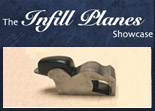Why Make A Hand Plane?
C.R. Miller explores the reasons why it might be desirable to start making your own hand planes and other tools.
Make Your Own Hand Planes? Why Would You Bother?
Back in 1994 I was giving a planemaking demonstration at a National woodworking show. The plane I was building was a coffin sided smoothing plane in bronze and steel, using plates dovetailed together. Now dovetailing in itself is a relatively easy method of construction – but unfortunately it is laboriously slow, especially if all the dovetailing is done by hand and you’re spending most of the time talking to the public.
Whilst filing away on one occasion I looked up to see a middle-aged man, and his wife, intently watching my every move. After a short time the man asked me what it was exactly that I was doing. I automatically went into explanation and demonstration mode, just as I had done a hundred or so times previously during the show. Seemingly satisfied with my presentation the man thanked me for my time and he and his wife proceeded to move on to the next booth. As they did so the wife turned to her husband and commented “Why would you bother?”
Why would you bother? Why would anyone bother to make a plane when you could just buy one from the local hardware store or even secondhand from a weekend market, antique store or, nowadays, eBay? It was certainly a question I hadn’t formally asked myself before, although I immediately knew the answer: Necessity! For me the necessity was two-fold. I wanted to make a plane and, secondly, I needed to make a plane.
The Specialty or Single Purpose Plane
Many years ago when I started making stringed musical instruments – Guitars, lutes, rebecs and the like – I needed a set of small luthiers planes. These very specialised planes are notoriously hard to find second hand in my local area. This was in the days before eBay (actually it was before the internet even), and “the worlds tools” were not available to me at that time.
Not to mention that these little planes also cost quite a bit of money brand new. Money that – for me at that time – would be better spent on other things such as food and rent, rather than expensive tools. My options, therefore, would be to go without a set of luthiers planes or to try my hand at making them myself. Of course I chose the latter.
Some years later, while working on another project I was once again in need of some specialty planes. Although my finances were somewhat more respectable at this time, there was no-one around who was making the types of planes that I needed. The only viable option was to, once again, design and make my own.
Quality or Quantity
In the latter half of the 19th Century and early into the 20th Century the manufacture of hand tools – and especially planes – had more or less reached its zenith, particularly in Great Britain. Competition was fierce between rival manufacturers as each tried to outdo the other on price, workmanship, range and quality. Labour was fairly cheap but material costs were generally high and it was not unusual for workers to spend a great deal of time making just one product. This was the era of great plane manufacturers such as Mathieson, Marples, Spiers, Norris, Holland, Preston and others. Even with low labour costs prices for many of the planes from these makers were the equivalent of two or three weeks wages for the average cabinetmaker. Hardly a decision to be taken lightly!
With the increase of automation and mass production within the manufacturing sector in the last one hundred years or so, there has been a dramatic decrease in the overall cost of the finished products. Unfortunately in many cases, there has been a noticeable decline in the quality of the finished products as well.
Even Stanley Tools, who have made woodworking planes for the last 140 years in a staggering range of variations (and who also embraced the concept and practice of mass production early on) have, over the years, let their standards slip. It is generally regarded by many craftspeople that the earlier planes by Stanley are superior in design, workmanship, quality and finish than those of latter years. It must be noted, however, that in Stanley’s defence the overall marketplace itself has a lower expectation of what’s required in a woodworking plane.
With a low material cost and an almost non existent labour cost (providing of course you have the spare time available) a quality woodworking plane can be yours for the making!
The Cost — Collector or Consumer
If someone wanted a good quality woodworking plane thirty or forty years ago all they had to do was to leisurely browse through the weekend markets and garage sales for second hand planes. It was that simple – almost anything was available, and for very little cost.
Nowadays, however, it’s a different story. More often than not if you want a quality plane and can afford the price tag that goes with it you will no doubt have to search though the various antique stores that specialise in old woodworking tools. Auction houses are often a good source for woodworking planes. Another solution is to seek out dealers though magazines and trade papers, or even on the internet. eBay, for instance, is a fantastic resource for hand planes, but you have to know what you’re looking for and approximately how much it’s worth, and then be prepared to lose out on a little money from time to time due to less than reputable sellers. Sometimes the prices they ask for even on eBay are often beyond the reach of many craftspeople. I would not necessarily say that these prices were over-inflated, but merely the result of supply verses demand. There are simply too many collectors and consumers (ie. craftspeople) of quality planes, and not enough of the planes themselves. Not enough to keep prices down anyway. Of course it goes without saying that most collectors want the best planes in the best condition – but, ideally, so does the craftsperson.
One advantage that the craftsperson has over the collector, however, is the ability to repair or replace broken or missing parts from a plane that may otherwise be considered unsuitable to a collector (providing of course that the craftsperson has the knowledge or skill to do this). I have acquired many woodworking planes in this manner and have paid very reasonable – and in some cases very cheap – prices for them.
Tradition — The Pride of Ones Own Making
In times past it was often a requirement that an apprentice, as part of his training, would be expected to make some of his own tools. This was not only an exercise to teach the apprentice new skills but also an opportunity to demonstrate his level of competency to others. I also suspect that apprentice wages being what they were – almost non existent – that this was an excellent way to acquire quality hand tools for very little cost.
The same principals still hold true today. For a minimal material cost the craftsperson can make a well designed, well balanced quality hand plane in any shape, size, pattern or style that he or she desires. With many different design and constructional variations, consideration can be given to suit different skill levels from quite basic to something a bit more challenging. The end result should be a plane, or planes, that one not only feels pride in owning and a pleasure and comfort in using, but also a tool that naturally extends the range and scope of ones own creativity.
The Information Super Highway
One excellent reason to consider making your own hand planes and other tools is the availability of information on offer to us nowadays. When I first started making infill planes there was very little to be found – a few sparse articles in some of the woodworking magazines and that was it! Even Jim Kingshott’s ground-breaking book “Making And Modifying Woodworking Tools” was still at the printers by the time I made my first planes (and boy, did I rush to the bookstore when I heard that book had been released). Nowadays – largely led by the internet – there’s a wealth of information for the wannabe plane maker. There are fantastic websites and articles all over the internet dedicated to plane making, collecting, restoring and using. The only problem is finding it all!
But you don’t need to know everything before you start making planes. The more information, the better off you’ll be, but there’s plenty to do already by reading various articles on Handplane Central and other sites. Just keep looking, experimenting, making and asking questions in the various forums that are around. Most of all, always try to keep an open mind and you should be fine.






